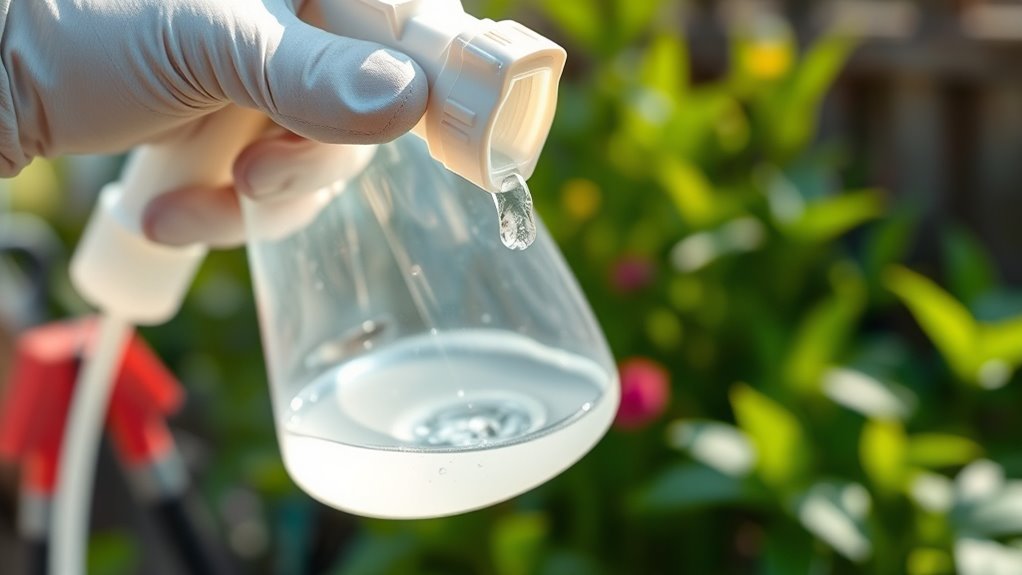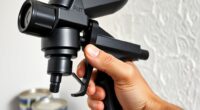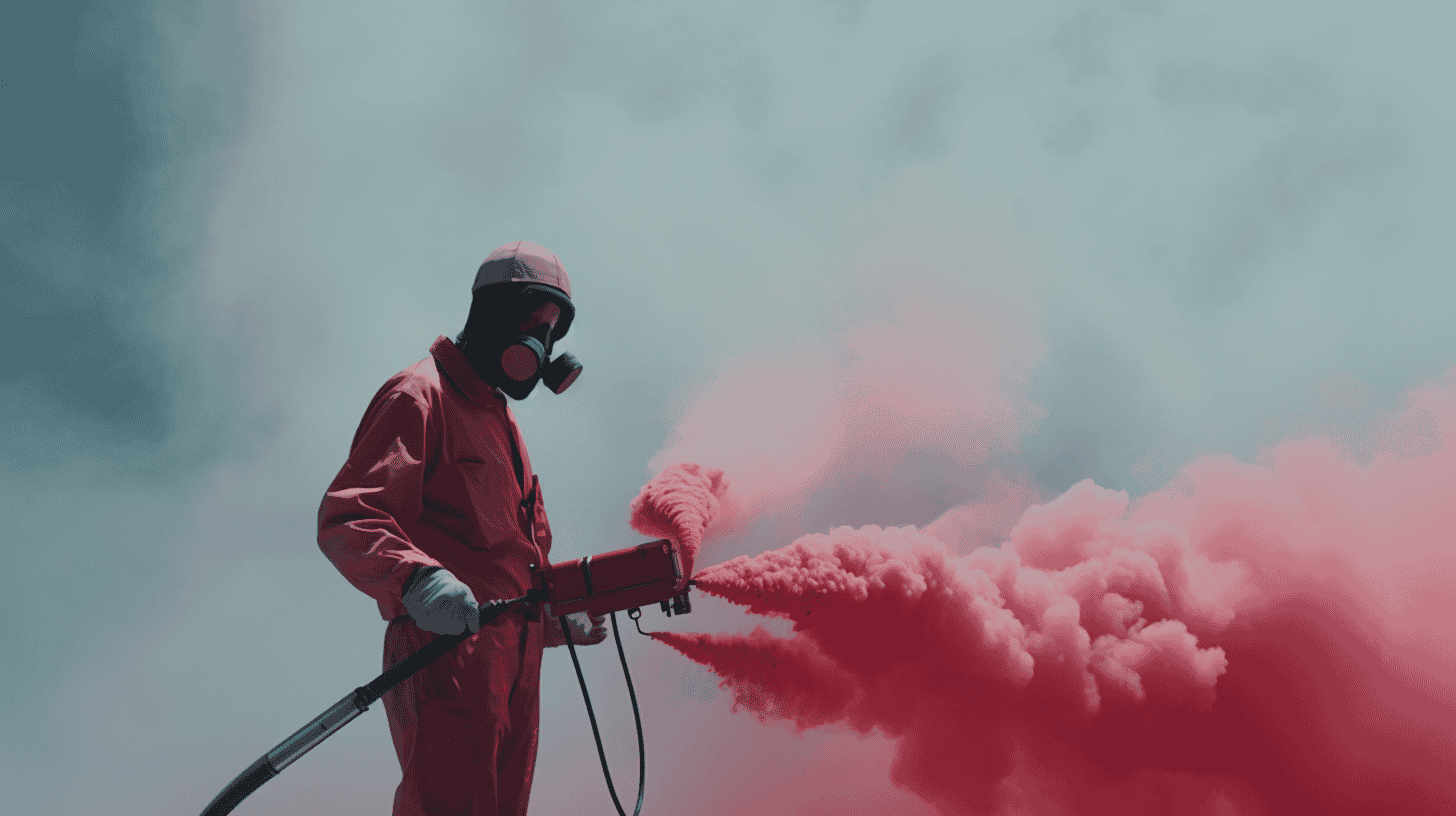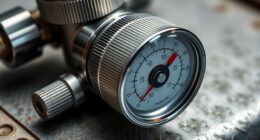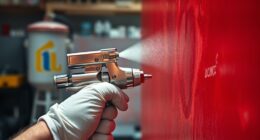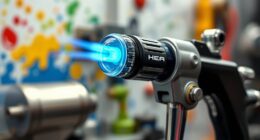To keep your sprayer in top shape, flush it regularly based on how often and what chemicals you use. If you apply chemicals frequently or switch types often, consider flushing after each session or at least every few uses. Use the appropriate solvent—water for water-based paints, mineral spirits for oil-based, or specialized cleaners for specific chemicals. Staying on top of proper flushing routines helps prevent clogs, damage, and guarantees effective spraying; learn more to optimize your maintenance.
Key Takeaways
- Flush your sprayer after each use to prevent chemical residue buildup and maintain optimal performance.
- Adjust flushing frequency based on chemical types and switching between different chemical classes.
- Use water for water-based paints and cleaners; mineral spirits or specialized sprayer cleaners for oil-based or stubborn residues.
- Disassemble nozzles and filters for thorough cleaning with the appropriate solvent, then rinse with water if needed.
- Regular maintenance and proper solvent selection extend sprayer lifespan and ensure consistent, clog-free operation.
Determining the Ideal Flushing Frequency Based on Usage
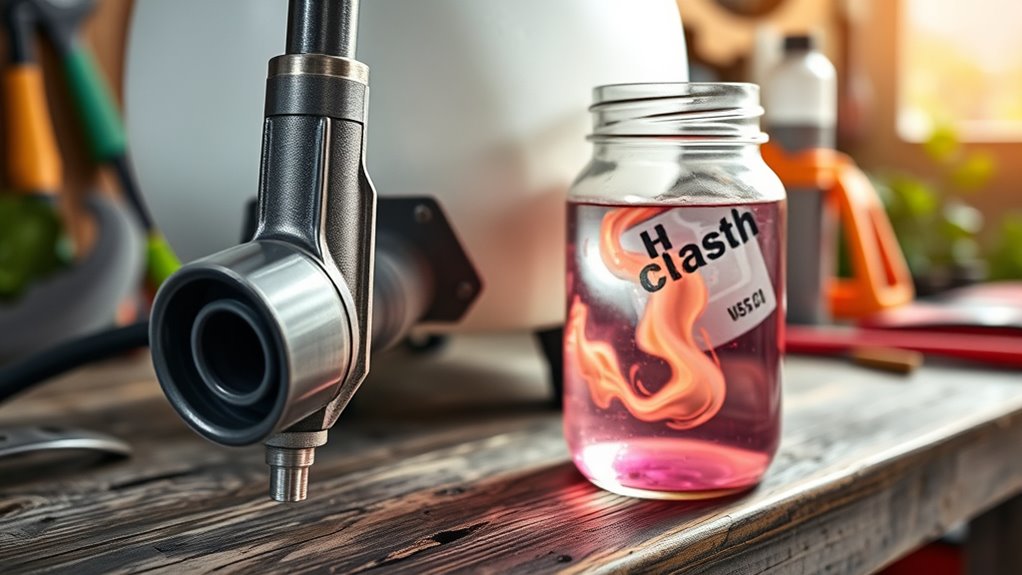
Understanding how often you should flush your sprayer depends largely on how frequently and what types of chemicals you use. The key is to ensure chemical compatibility, as mixing incompatible substances can cause damage or reduce effectiveness. If you’re spraying multiple chemicals regularly, increase your flushing frequency to prevent residue buildup and chemical reactions. For occasional use with similar chemicals, flushing after each session may suffice. Conversely, if you switch between different chemical classes frequently, more frequent flushing is essential to avoid contamination. Pay close attention to manufacturer guidelines and chemical labels, which often specify recommended flushing intervals. Proper cleaning practices support environmental considerations by minimizing chemical residues that could harm surrounding ecosystems. Additionally, regular maintenance can help prevent system failures and ensure consistent performance. To further safeguard your equipment, understanding material compatibility can guide your cleaning and flushing routines. Being aware of chemical residues and how they interact with different materials can help you choose the most effective cleaning agents. Staying informed about regulatory compliance can also prevent legal issues related to improper chemical disposal or equipment maintenance. Ultimately, adjusting your flushing routine based on your usage patterns ensures your sprayer remains in top condition and prolongs its lifespan.
Selecting the Appropriate Solvent for Your Sprayer
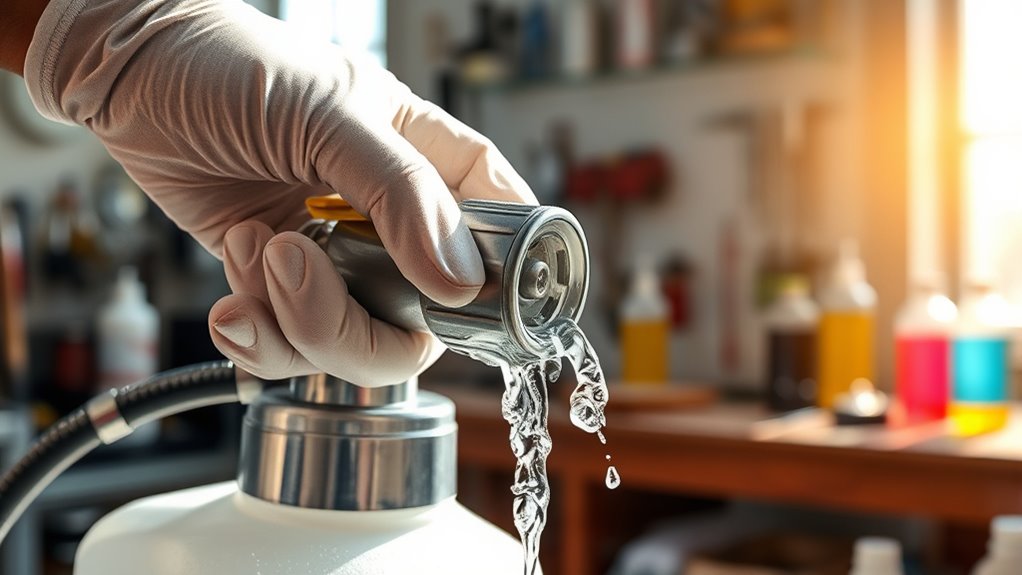
Choosing the right solvent is essential for effectively cleaning your sprayer without causing damage. To guarantee chemical compatibility and solvent safety, consider these options:
Selecting the proper solvent ensures effective cleaning and protects your sprayer’s durability.
- Water—best for water-based paints and cleaners.
- Mineral spirits—ideal for oil-based paints and compatible with many sprayer components.
- Commercial sprayer cleaners—designed for specific chemicals, ensuring safety and compatibility.
- Acetone or alcohol—useful for fast evaporation but check material compatibility first. Understanding the material compatibility of your sprayer components helps prevent unintended deterioration.
Additionally, recognizing the compatibility of solvents with different materials can help you select the safest option for your equipment. Always verify that the solvent is compatible with your sprayer’s materials to prevent deterioration. Using an incompatible solvent can damage seals or corrode parts. Prioritize solvents that are safe for your specific application, and follow manufacturer recommendations to avoid hazards or damage. Chemical compatibility is a crucial factor to consider when selecting a solvent. Selecting the correct solvent ensures thorough cleaning without risking your equipment’s longevity.
Step-by-Step Guide to Properly Flush Your Equipment
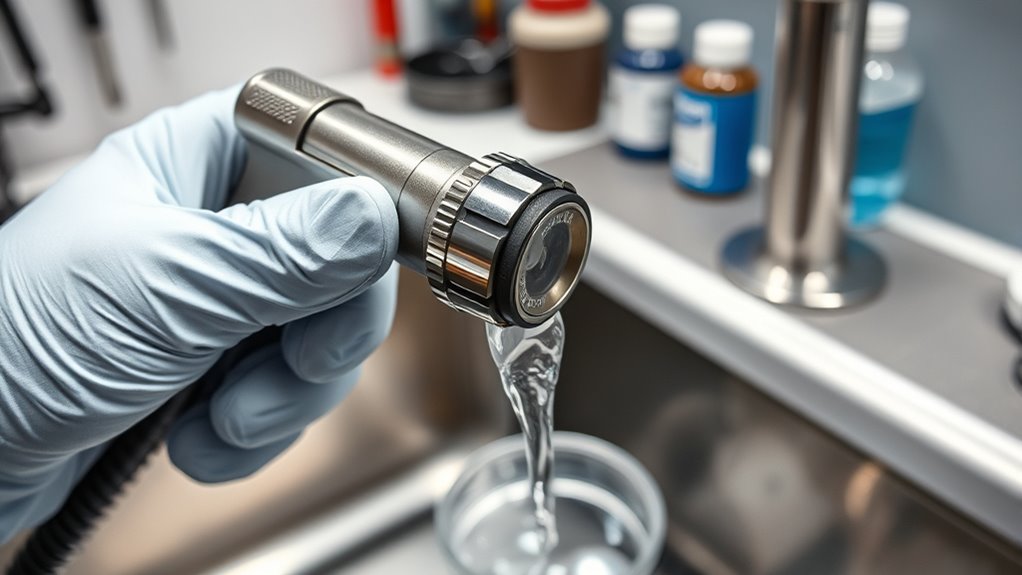
Once you’ve selected the appropriate solvent, the next step is to properly flush your sprayer to remove residual paint or chemicals. Start by filling the sprayer with the solvent and spraying it through the entire system, including the nozzle and hoses. This guarantees thorough cleaning. Be sure to clean your equipment regularly—based on your cleaning frequency—to prevent buildup and maintain solvent effectiveness. After spraying, disassemble parts like the nozzle and clean them separately with the solvent. Rinse the tank and hoses with clean water if necessary. Dry all parts before reassembling. Proper flushing not only prolongs your sprayer’s lifespan but also ensures optimal maintenance, which is crucial for preventing contamination and ensuring safety. Regular cleaning keeps your equipment in top condition and ensures your project’s quality, especially considering that easy cleanup is one of the key benefits of using airless paint sprayers. Additionally, using the correct cleaning solvents tailored to your paint type can significantly improve the efficiency of your cleaning process. Maintaining your equipment according to the family background of the manufacturer’s recommendations can also extend its longevity and performance.
Signs That Indicate Your Sprayer Needs Immediate Cleaning
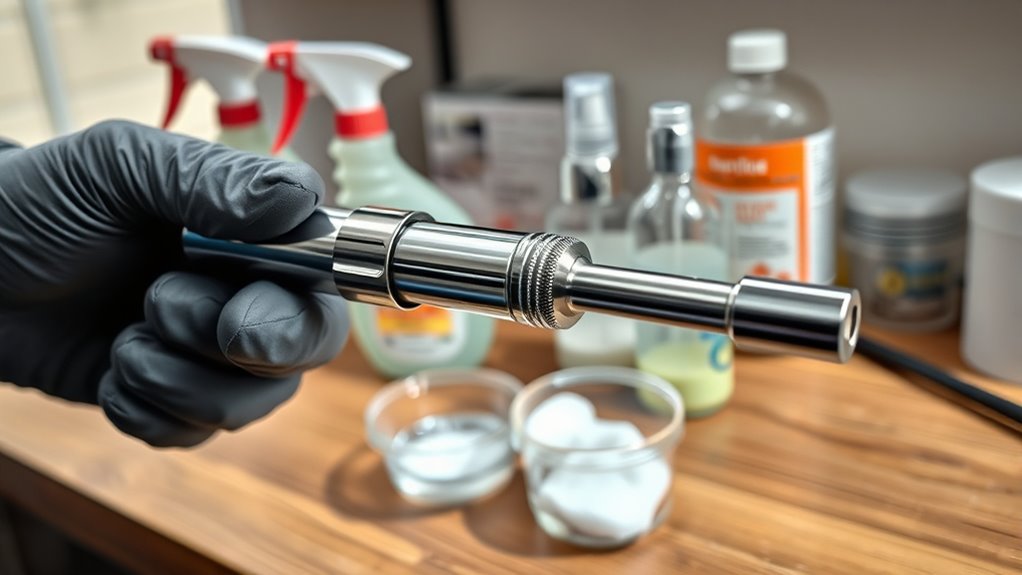
Your sprayer may need immediate cleaning if you notice uneven spray patterns or clogging the nozzle. Chemical residue buildup can cause inconsistent application, while nozzle clogging hampers proper spray distribution. Be alert to these signs:
- Spray pattern becomes uneven or drips.
- Reduced spray pressure or volume.
- Persistent clogging even after initial cleaning.
- Visible chemical residue around the nozzle or inside the tank.
- Regular maintenance can prevent these issues from escalating. Proper cleaning and equipment care are essential for maintaining optimal performance. Staying informed about security system developments can help you better protect your equipment from theft or damage.
If you observe any of these, it’s a clear sign your sprayer requires urgent cleaning. Ignoring these issues can lead to chemical residue buildup, further clogging, or damage to your equipment. Timely inspection and cleaning help prevent costly repairs and ensure smooth operation. Additionally, staying informed about innovations in AI-driven solutions can revolutionize maintenance strategies, ensuring your equipment remains in top condition.
Tips for Maintaining Your Sprayer’s Longevity and Performance
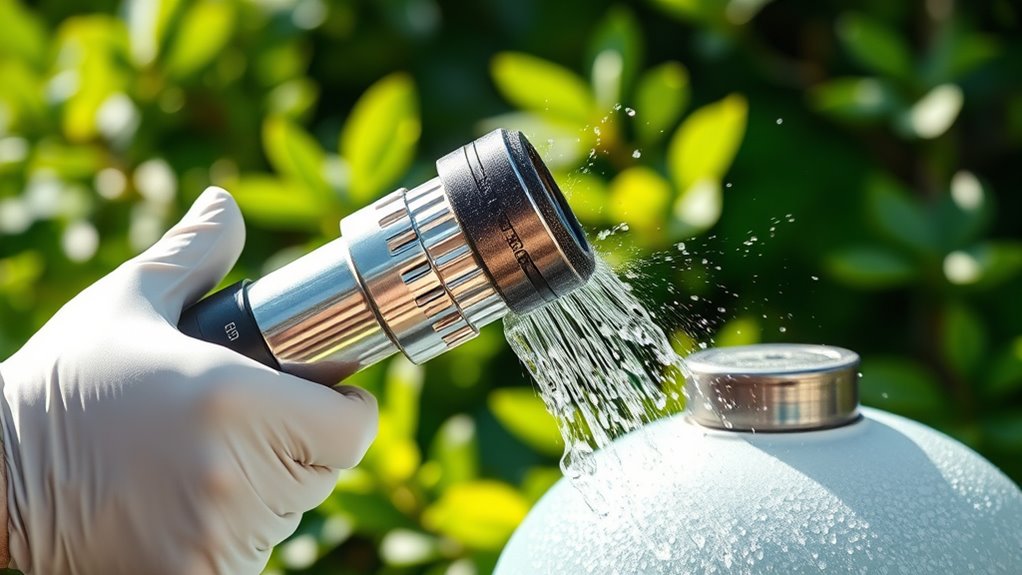
Regular maintenance is essential to keep your sprayer functioning at its best and extend its lifespan. Always check chemical compatibility before using any products to prevent damage to seals and parts. Rinse your sprayer thoroughly after each use to remove residue and prevent clogging. When storing, follow storage precautions, such as emptying and cleaning the tank, to avoid corrosion and material degradation. Store your sprayer in a cool, dry place away from direct sunlight and extreme temperatures. Regularly inspect components like nozzles, filters, and hoses for wear and replace them as needed. Proper maintenance reduces downtime and repairs, ensuring consistent performance. By paying attention to chemical compatibility and storage precautions, you’ll maximize your sprayer’s longevity and keep it operating smoothly. Additionally, monitoring projector technology advancements can help you choose the best equipment for your needs. Regularly cleaning and inspecting filters and hoses also helps prevent clogging and ensures optimal paint flow. Incorporating sound healing science principles, such as the use of specific frequencies, can even aid in the relaxation of your workspace environment, promoting better focus during maintenance routines. Staying informed about cybersecurity trends can also help protect your equipment from digital threats and unauthorized access. Furthermore, understanding keto diet plans can inspire healthier lifestyle choices that support overall well-being.
Frequently Asked Questions
Can I Reuse the Flushed Solvent for Future Spraying?
You might wonder if you can reuse the flushed solvent for future spraying. It’s important to check chemical compatibility first, as some residues can cause reactions or clog your equipment. Reusing solvent depends on effective solvent recovery, meaning it’s been properly filtered and free of contaminants. If the recovered solvent remains chemically compatible and clean, you can reuse it safely. Otherwise, it’s best to dispose of it to avoid issues during future spraying.
How Do Environmental Factors Affect My Flushing Schedule?
Ever wonder how environmental impact influences your flushing frequency? Environmental factors like temperature, humidity, and chemical exposure can accelerate or slow down residue buildup in your sprayer. You should adjust your flushing schedule accordingly to prevent contamination and maintain efficiency. Ignoring these factors may lead to increased chemical waste or damage to your equipment. Stay mindful of your surroundings to optimize your maintenance routine and reduce environmental harm.
Are There Specific Safety Precautions During Flushing?
When you flush your sprayer, safety is key. Always wear personal protective equipment like gloves, goggles, and a mask to prevent exposure to chemicals. Make certain proper ventilation by working outdoors or in a well-ventilated area to avoid inhaling fumes. Follow all safety guidelines and manufacturer’s instructions closely, and dispose of solvents responsibly. Taking these precautions helps protect your health and keeps your workspace safe.
What Are Common Mistakes to Avoid When Flushing?
When flushing your sprayer, avoid common mistakes like neglecting proper disposal of leftover solvents, which can be hazardous. Don’t skip thorough cleaning, as residue can cause equipment corrosion over time. Always follow manufacturer instructions and use the right solvents for flushing. Rushing the process or not rinsing enough can lead to damage and contamination. Proper disposal and careful cleaning guarantee your sprayer stays in top condition and lasts longer.
How Does the Type of Chemical Impact Flushing Procedures?
You might think all chemicals need the same flushing process, but that’s not true. The type of chemical influences your flushing procedures because of chemical compatibility. You must choose the right solvent to prevent damage or residue buildup, especially with stubborn or reactive substances. Proper solvent selection ensures thorough cleaning, protects your equipment, and avoids costly mistakes, making your spraying process more efficient and safe.
Conclusion
Regularly tending to your sprayer ensures it stays in top shape, quietly rewarding you with smooth, reliable performance. By paying attention to subtle signs and giving it proper care, you nurture a lasting partnership that saves you time and effort down the line. Think of cleaning as a gentle conversation with your equipment—small, thoughtful gestures that keep everything flowing seamlessly. In caring for your sprayer, you’re really cultivating its quiet strength for future adventures.
